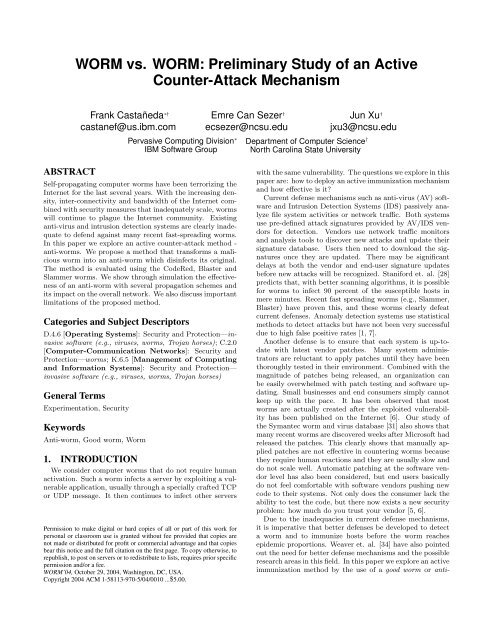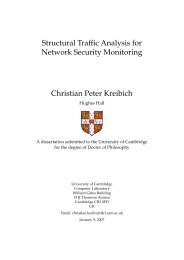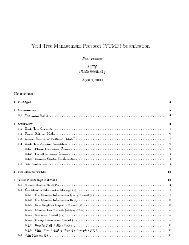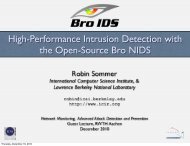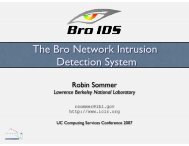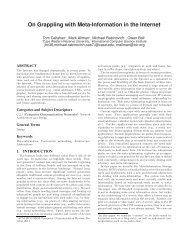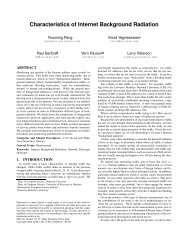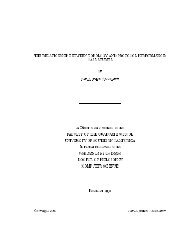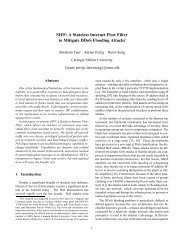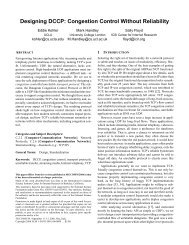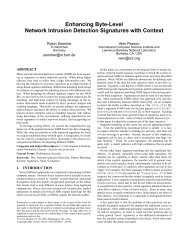WORM vs. WORM - The ICSI Networking and Security Group
WORM vs. WORM - The ICSI Networking and Security Group
WORM vs. WORM - The ICSI Networking and Security Group
You also want an ePaper? Increase the reach of your titles
YUMPU automatically turns print PDFs into web optimized ePapers that Google loves.
<strong>WORM</strong> <strong>vs</strong>. <strong>WORM</strong>: Preliminary Study of an Active<br />
Counter-Attack Mechanism<br />
Frank Castañeda ∗†<br />
castanef@us.ibm.com<br />
Pervasive Computing Division ∗<br />
IBM Software <strong>Group</strong><br />
Emre Can Sezer †<br />
ecsezer@ncsu.edu<br />
Jun Xu †<br />
jxu3@ncsu.edu<br />
Department of Computer Science †<br />
North Carolina State University<br />
ABSTRACT<br />
Self-propagating computer worms have been terrorizing the<br />
Internet for the last several years. With the increasing density,<br />
inter-connectivity <strong>and</strong> b<strong>and</strong>width of the Internet combined<br />
with security measures that inadequately scale, worms<br />
will continue to plague the Internet community. Existing<br />
anti-virus <strong>and</strong> intrusion detection systems are clearly inadequate<br />
to defend against many recent fast-spreading worms.<br />
In this paper we explore an active counter-attack method -<br />
anti-worms. We propose a method that transforms a malicious<br />
worm into an anti-worm which disinfects its original.<br />
<strong>The</strong> method is evaluated using the CodeRed, Blaster <strong>and</strong><br />
Slammer worms. We show through simulation the effectiveness<br />
of an anti-worm with several propagation schemes <strong>and</strong><br />
its impact on the overall network. We also discuss important<br />
limitations of the proposed method.<br />
Categories <strong>and</strong> Subject Descriptors<br />
D.4.6 [Operating Systems]: <strong>Security</strong> <strong>and</strong> Protection—invasive<br />
software (e.g., viruses, worms, Trojan horses); C.2.0<br />
[Computer-Communication Networks]: <strong>Security</strong> <strong>and</strong><br />
Protection—worms; K.6.5 [Management of Computing<br />
<strong>and</strong> Information Systems]: <strong>Security</strong> <strong>and</strong> Protection—<br />
invasive software (e.g., viruses, worms, Trojan horses)<br />
General Terms<br />
Experimentation, <strong>Security</strong><br />
Keywords<br />
Anti-worm, Good worm, Worm<br />
1. INTRODUCTION<br />
We consider computer worms that do not require human<br />
activation. Such a worm infects a server by exploiting a vulnerable<br />
application, usually through a specially crafted TCP<br />
or UDP message. It then continues to infect other servers<br />
Permission to make digital or hard copies of all or part of this work for<br />
personal or classroom use is granted without fee provided that copies are<br />
not made or distributed for profit or commercial advantage <strong>and</strong> that copies<br />
bear this notice <strong>and</strong> the full citation on the first page. To copy otherwise, to<br />
republish, to post on servers or to redistribute to lists, requires prior specific<br />
permission <strong>and</strong>/or a fee.<br />
<strong>WORM</strong>’04, October 29, 2004, Washington, DC, USA.<br />
Copyright 2004 ACM 1-58113-970-5/04/0010 ...$5.00.<br />
with the same vulnerability. <strong>The</strong> questions we explore in this<br />
paper are: how to deploy an active immunization mechanism<br />
<strong>and</strong> how effective is it?<br />
Current defense mechanisms such as anti-virus (AV) software<br />
<strong>and</strong> Intrusion Detection Systems (IDS) passively analyze<br />
file system activities or network traffic. Both systems<br />
use pre-defined attack signatures provided by AV/IDS vendors<br />
for detection. Vendors use network traffic monitors<br />
<strong>and</strong> analysis tools to discover new attacks <strong>and</strong> update their<br />
signature database. Users then need to download the signatures<br />
once they are updated. <strong>The</strong>re may be significant<br />
delays at both the vendor <strong>and</strong> end-user signature updates<br />
before new attacks will be recognized. Staniford et. al. [28]<br />
predicts that, with better scanning algorithms, it is possible<br />
for worms to infect 90 percent of the susceptible hosts in<br />
mere minutes. Recent fast spreading worms (e.g., Slammer,<br />
Blaster) have proven this, <strong>and</strong> these worms clearly defeat<br />
current defenses. Anomaly detection systems use statistical<br />
methods to detect attacks but have not been very successful<br />
due to high false positive rates [1, 7].<br />
Another defense is to ensure that each system is up-todate<br />
with latest vendor patches. Many system administrators<br />
are reluctant to apply patches until they have been<br />
thoroughly tested in their environment. Combined with the<br />
magnitude of patches being released, an organization can<br />
be easily overwhelmed with patch testing <strong>and</strong> software updating.<br />
Small businesses <strong>and</strong> end consumers simply cannot<br />
keep up with the pace. It has been observed that most<br />
worms are actually created after the exploited vulnerability<br />
has been published on the Internet [6]. Our study of<br />
the Symantec worm <strong>and</strong> virus database [31] also shows that<br />
many recent worms are discovered weeks after Microsoft had<br />
released the patches. This clearly shows that manually applied<br />
patches are not effective in countering worms because<br />
they require human reactions <strong>and</strong> they are usually slow <strong>and</strong><br />
do not scale well. Automatic patching at the software vendor<br />
level has also been considered, but end users basically<br />
do not feel comfortable with software vendors pushing new<br />
code to their systems. Not only does the consumer lack the<br />
ability to test the code, but there now exists a new security<br />
problem: how much do you trust your vendor [5, 6].<br />
Due to the inadequacies in current defense mechanisms,<br />
it is imperative that better defenses be developed to detect<br />
a worm <strong>and</strong> to immunize hosts before the worm reaches<br />
epidemic proportions. Weaver et. al. [34] have also pointed<br />
out the need for better defense mechanisms <strong>and</strong> the possible<br />
research areas in this field. In this paper we explore an active<br />
immunization method by the use of a good worm or anti-
worm. <strong>The</strong> idea is to transform a malicious worm into an<br />
anti-worm which spreads itself using the same mechanism<br />
as the original worm <strong>and</strong> immunizes a host.<br />
We propose an architecture to generate an anti-worm.<br />
<strong>The</strong>re are several major challenges in the architecture: new<br />
worm detection, transforming a worm into an anti-worm,<br />
<strong>and</strong> anti-worm propagation schemes. New worm detection<br />
is an ongoing research area. Designing <strong>and</strong> implementing<br />
a completely automated anti-worm generator may require<br />
extensive research. We leverage a Honey-pot based system<br />
[24] in our current proposal for worm detection <strong>and</strong> capture.<br />
<strong>The</strong> focus of this paper is on worm transformation<br />
<strong>and</strong> propagation schemes. After we capture a new worm<br />
we transform the message of the original worm into an antiworm<br />
through a payload search algorithm, we then generate<br />
anti-worm code <strong>and</strong> embed it in the payload. <strong>The</strong> job of the<br />
anti-worm code is to stop the activities of an existing worm<br />
in a system, <strong>and</strong> detect <strong>and</strong> prevent new attacks against the<br />
hosting machine (i.e., immunization). <strong>The</strong> transformation<br />
method is evaluated using three recent worms: CodeRed,<br />
Slammer <strong>and</strong> Blaster. An important requirement for an<br />
anti-worm is that it must be able to suppress the overall<br />
activities of the original worm, <strong>and</strong> in the process, not pose<br />
significant traffic load on the network. We show the effectiveness<br />
of four anti-worm propagation schemes (passive,<br />
active, hybrid, <strong>and</strong> IDS-based) through simulation.<br />
<strong>The</strong> paper is organized as follows: §2 highlight the unresolved<br />
issues <strong>and</strong> limitations of the proposed approach;<br />
§3 discusses background <strong>and</strong> related work in active defense<br />
mechanisms; §4 discusses the anti-worm generation <strong>and</strong> transformation<br />
algorithms; §5 presents the anti-worm propagation<br />
schemes <strong>and</strong> simulation results; we conclude with §6.<br />
We discuss related work throughout the paper.<br />
2. ISSUES AND LIMITATIONS<br />
Later in the paper, we propose four types of anti-worm<br />
propagation methods: a passively spreading anti-worm which<br />
responds to worm probes with a counterattack; an activescanning<br />
anti-worm which actively finds targets <strong>and</strong> propagate<br />
to them; a hybrid scheme that combines the features of<br />
the passive <strong>and</strong> active anti-worms; <strong>and</strong> an IDS based antiworm<br />
where an IDS or similar device intercept attack messages<br />
<strong>and</strong> counter-attacks [21]. However, the proposed antiworms<br />
in their current forms have several unresolved issues<br />
<strong>and</strong> limitations that are almost certain to cause serious deployment<br />
problems. We highlight some of these issues in<br />
this section.<br />
Patching Worms. A patching worm can be in various<br />
forms: explicit or implicit. A worm could patch a system<br />
explicitly by removing the vulnerability that it exploits<br />
in the system. Welchia [15] is such an example, downloading<br />
the patch to prevent other worms from competing<br />
with it. Patching occurs implicitly if the worm infects<br />
a single-threaded service, where the act of infection<br />
blocks further exploitation. Common worms such as Slammer<br />
[18], Witty [29], <strong>and</strong> (to a limited extent) Blaster [30]<br />
1 all infected such services <strong>and</strong> blocked secondary infection<br />
1 Blaster blocked the RPC service during infection until the<br />
next reset. This block was only temporary, however, as Windows<br />
XP automatically resets after 1 minute of RPC failure,<br />
while Windows 2K is commonly reset by users as RPC failattempts.<br />
A patching worm will completely disable the proposed<br />
passive anti-worm in its current form. <strong>The</strong> effect of<br />
the active-scanning is limited to only protecting uninfected<br />
systems, while IDS-based strike-back can only replace an infectious<br />
attempt monitored by an IDS, therefore limiting its<br />
effectiveness.<br />
Network Impact. <strong>The</strong> main goal of the proposed antiworm<br />
is to stop the spreading of malicious worms. For this<br />
purpose, the anti-worm itself needs to be generated quickly<br />
<strong>and</strong> spread at least as fast as the original worm. <strong>The</strong>re<br />
could be several problems with this. A worm could spread<br />
so fast that either the traffic due to a very fast anti-worm<br />
could cause similar damage, or the anti-worm would be too<br />
slow to stop the original worm. In the case of the Slammer<br />
worm, even if a perfect anti-Slammer can be generated automatically,<br />
it would be at least as disruptive as the original<br />
Slammer for the duration of its spread.<br />
In addition, our method relies on the original worm to<br />
generate the corresponding anti-worm. A buggy worm may<br />
result in a buggy anti-worm, which may lead to instability<br />
in the target network. Even without bugs, the active<br />
anti-worm is equally disruptive to the network during the<br />
spreading process, although this disruption may be more<br />
transitory if it is programmed to stop after a certain period<br />
of time.<br />
Legal Issues. It is currently grossly illegal to intrude a<br />
system that one does not control. Legal <strong>and</strong> trust issues<br />
make it hard for anti-worms to be accepted as an active defense<br />
mechanism. <strong>The</strong> current proposed Internet-scale antiworm<br />
will also have legal issues across judiciary boundaries,<br />
where applicable laws may vary in different countries. Crossjurisdictional<br />
issues could stop governments, as well as private<br />
entities, from employing anti-worms. This limits the<br />
use of anti-worm to local confined domains. For example,<br />
a private company can choose to use anti-worm within its<br />
corporate network where it has full legal access. Research<br />
has shown [27] that limiting the spread of a worm, even ones<br />
with manual designers, is often very hard.<br />
Network <strong>and</strong> Patch Management. Current or future<br />
enhanced network management tools <strong>and</strong> patch management<br />
tools can accomplish similar goals without aforementioned<br />
technical problems even if the anti-worms can be<br />
limited to systems fully-controlled by a defender. A lot of<br />
the patch management infrastructure is not in place yet, but<br />
the current systems can be further enhanced. If one has administrative<br />
control over a set of machines, these methods<br />
offer advantages over the proposed anti-worm schemes. For<br />
example, proposed patch-management systems could allow<br />
you to preventively immunize systems in a controlled domain<br />
within seconds, faster than scanning worms can propagate.<br />
Likewise, infected machines can be constrained or removed<br />
by network management, by techniques such as VLANing<br />
suspicious systems onto a different virtual network, isolating<br />
them from the rest of the enterprise.<br />
We have discussed only some of the major limitations<br />
of our approach. <strong>The</strong> proposed anti-worm in its current<br />
form will have practical usage problems. In spite of these<br />
ure stops both cut <strong>and</strong> paste, as well as drag <strong>and</strong> drop from<br />
working.
probably serious limitations, we still find the idea of an automatically<br />
generated anti-worm an intriguing one. <strong>The</strong><br />
techniques developed here (transforming a worm into an<br />
anti-worm with its own payload, <strong>and</strong> anti-worm propagation<br />
schemes in particular) would certainly be interesting to<br />
other researchers for studying future worms <strong>and</strong> for inventing<br />
new techniques.<br />
3. BACKGROUND<br />
Anti-worms pose several novel features, for one they allow<br />
for a reactive measure to malicious worms that can potentially<br />
be deployed with no additional infrastructure in<br />
place. Anti-virus software, firewalls, IDS <strong>and</strong> IPS are generally<br />
static in nature <strong>and</strong> only prevent known attacks, therefore<br />
must be updated periodically to stay current. We have<br />
already shown that humans do not scale against fast spreading<br />
worms. We also find that many computer systems today<br />
still have major security holes [25].<br />
Automatic patching systems present a security risk since<br />
the vendor now has full control over what software is running<br />
on your computer. Secondly, these patching systems<br />
are only effective against worms that exploit known vulnerabilities<br />
that have patches available. Anti-worms, however,<br />
do not need to carry a patch. <strong>The</strong>y may block traffic to the<br />
affected service with application specific filtering <strong>and</strong> detection.<br />
Anti-worms can also notify users of specific worms<br />
<strong>and</strong> vulnerabilities to reduce the risk of incompatible <strong>and</strong><br />
un-tested patches.<br />
To date, anti-worms <strong>and</strong> their effect have not been fully<br />
explored. We discuss some existing worms that we consider<br />
anti-worms below.<br />
<strong>The</strong> Welchia (Anti)Worm is a Blaster worm variant. This<br />
worm exploits the issue that was addressed by Microsoft<br />
<strong>Security</strong> Bulletin MS03-026, a buffer overflow vulnerability<br />
in the Microsoft Remote Procedure Call (RPC) service.<br />
<strong>The</strong> Welchia <strong>and</strong> Blaster worms both use TCP port 135 to<br />
spread. <strong>The</strong> Welchia anti-worm uses the same vulnerability<br />
to infect hosts, it then downloads the MS03-026 patch <strong>and</strong><br />
reboots the system to immunize the host. <strong>The</strong> combined effect<br />
of both worms was devastating to the network, because<br />
of the b<strong>and</strong>width used to download the patch by Welchia<br />
<strong>and</strong> the DoS attack on windowsupdate.com by Blaster. One<br />
variant of Welchia attempted to win over the Blaster worm<br />
by using 300 propagation threads instead of the original<br />
50, theoretically giving the anti-worm a 6x scanning rate.<br />
Welchia was more destabilizing than blaster, because it used<br />
an unrestricted ICMP scanner with a short timeout, which<br />
generated considerably more network traffic. This is what<br />
destabilized the navy marine corps intranet. <strong>The</strong>re were<br />
mixed reactions towards the anti-worm [15]. Whether Welchia<br />
had a ”good” intent is questionable, as at least some Welchia<br />
variants reportedly contained code to create an unrestricted<br />
back-door on all infected systems. Rather, Welchia’s patching<br />
<strong>and</strong> blaster-removal functions can also be interpreted as<br />
the worm author’s attempt to remove competitors from the<br />
Internet ecology, <strong>and</strong> as a tool to prevent duplicate infections<br />
without the complexity or possibility of errors in other<br />
techniques, such as the one used by the Morris worm [4].<br />
<strong>The</strong> CRClean Anti-Worm is a Code-Red II variant. This<br />
worm exploits Microsoft <strong>Security</strong> Bulletin MS01-033, a buffer<br />
overflow vulnerability in the Index Server plug-in for Microsoft’s<br />
web server. Though the CRClean worm was never<br />
released it presented some novel ideas; first of all it was<br />
a passive worm, meaning it only spread to machines that<br />
attempted to attack it. This ”counter-attack” scheme prevents<br />
the network perturbation normally caused by actively<br />
scanning worms. Secondly, it would add a filter to intercept<br />
the Code-Red attack before it infected the machine, rather<br />
than attempt to download the patch from Microsoft, thus<br />
having a ”blocking” effect against future infections. In this<br />
paper, CRClean is an excellent example of the schemes we<br />
plan to investigate: block <strong>and</strong> counter-attack [13].<br />
<strong>The</strong> Code-Green Anti-Worm is another Code-Red II<br />
worm variant which contains a payload designed to remove<br />
Code-Red <strong>and</strong> download the MS01-033 patch from Microsoft<br />
<strong>and</strong> install it. This worm, like CRClean was never released<br />
on the Internet [8].<br />
<strong>The</strong> Cheese Anti-Worm spreads through a backdoor opened<br />
by the Lion Linux worm. <strong>The</strong> Lion worm uses a buffer overflow<br />
vulnerability in the Transaction Signature (TSIG) part<br />
of a DNS/BIND message on UDP port 53. <strong>The</strong> Cheese Anti-<br />
Worm removes the backdoor created by Lion <strong>and</strong> the vulnerable<br />
service from inetd. Both the worm <strong>and</strong> anti-worm<br />
were released on the Internet but were very sparse <strong>and</strong> there<br />
was little known effect on the network or system resources.<br />
This may be due to the wide knowledge of the exploit <strong>and</strong><br />
small number of susceptible hosts [26].<br />
4. ANTI-<strong>WORM</strong> GENERATION<br />
We first describe a general framework for detecting, capturing,<br />
<strong>and</strong> analyzing an Internet worm, <strong>and</strong> for generating<br />
its anti-worm. Figure 1 illustrates the proposed architecture.<br />
<strong>The</strong> framework is divided into three stages: (1) worm<br />
detection <strong>and</strong> capture, (2) worm analysis, <strong>and</strong> (3) anti-worm<br />
generation. We investigate the feasibility of stages (1) <strong>and</strong><br />
(2) <strong>and</strong> suggest some potential ideas for further research.<br />
<strong>The</strong> focus of this paper, however, is on stage (3). We implement<br />
our proposal for anti-worm generation <strong>and</strong> have evaluated<br />
the algorithm using three real Internet worms: Code<br />
Red I, MSBlaster, <strong>and</strong> SQL Slammer.<br />
Stage 1: Detection<br />
(1)<br />
TCP/UDP Worm<br />
Worm Message<br />
Blocked Outgoing<br />
Worm Message<br />
Stage 2: Analysis<br />
Stage 3: Generation<br />
Network<br />
Monitor<br />
(IDS)<br />
Apply Heuristics<br />
(6)<br />
Generate Possible<br />
Anti-worms<br />
(2)<br />
(3)<br />
(Clean)<br />
Active<br />
Virtual Machine<br />
Honey Pot<br />
(4)<br />
(Infected)<br />
Active<br />
Virtual Machine<br />
(5)<br />
=<br />
Compare active<br />
Processes, Disk,<br />
<strong>and</strong> Registry State<br />
(7)<br />
Deploy &Test<br />
Anti-worm<br />
Figure 1: Architecture<br />
(Clean)<br />
Dormant<br />
(Clean)<br />
Virtual Machines<br />
Virtual (Clean) Machine<br />
Virtual (Clean) Machine<br />
Virtual (Clean) Machine<br />
Virtual Machine<br />
(8)<br />
(Immune)<br />
Virtual (Clean) Machine<br />
Virtual (Clean) Machine<br />
Virtual (Clean) Machine<br />
Virtual Machine<br />
Stage 1 - Worm Detection <strong>and</strong> Capture. <strong>The</strong> challenge<br />
for this stage is to be able to distinguish between net-
work messages from worm traffic <strong>and</strong> non-worm traffic. Existing<br />
work on Honey Pot based IDS systems [24] may be<br />
leveraged for this stage. A honeypot is a monitored system<br />
connected to a network as a decoy, whose sole purpose is<br />
to collect traffic from scanning worms <strong>and</strong> attackers. By<br />
definition, a honeypot system has no legitimate traffic. <strong>The</strong><br />
system is only accessible to an entity that is performing<br />
r<strong>and</strong>om scanning. <strong>The</strong> system uses a database of signatures<br />
of known traffic which is ignored. This can be any traffic<br />
that is seen before <strong>and</strong> has already been analyzed <strong>and</strong> recognized.<br />
<strong>The</strong> worm detection <strong>and</strong> capture process starts as<br />
soon as any new message enters a honeypot system. <strong>The</strong><br />
honeypot can use LCS (Longest Common Substring) based<br />
pattern matching on messages entering <strong>and</strong> exiting the system<br />
until a certain threshold of similar messages are seen<br />
on the network before signaling a worm presence. A vertical<br />
<strong>and</strong> horizontal LCS scheme was used by Kreibich et.<br />
al. [14] when creating IDS signatures using honeypots, <strong>and</strong><br />
has proven to be successful against Code-Red <strong>and</strong> Slammer<br />
worms.<br />
At Step (1) in Figure 1, the worm message enters the<br />
system <strong>and</strong> the network monitor records the message. At<br />
this point the system does not know if the message is a<br />
worm or not. In (2) the message is received by an active<br />
Virtual Machine (VM) image which is running the application<br />
suite containing a vulnerable application. <strong>The</strong> use of<br />
VMs is based on the assumption that the vulnerable application<br />
is unknown <strong>and</strong> not easily discernible. In (3) <strong>and</strong> (4)<br />
the now infected VM retransmits the same or similar (replayed)<br />
worm message. Here the network monitor waits for<br />
this repeat message (with an alternate destination) to determine<br />
that VM is infected <strong>and</strong> attempting to spread the<br />
worm to others. <strong>The</strong> source <strong>and</strong> destination port number of<br />
the attack message <strong>and</strong> the message itself is recorded <strong>and</strong><br />
sent to the generation module.<br />
Stage 2 - Worm Analysis. At Step (5) in Stage 2, the<br />
VM may be compared with a dormant version of the VM.<br />
<strong>The</strong> dormant VM is one that was created from a backup of<br />
the now infected VM some time before it was infected (there<br />
may be several backups created from different times.) In (6)<br />
data is collected from the comparison of the before-infection<br />
<strong>and</strong> after-infection VMs, including what files changed on<br />
the system, what registry entries were changed <strong>and</strong> what<br />
processes were started. This data may then be used to generate<br />
an anti-worm that repairs any registry changes or file<br />
changes or processes started by the malicious worm.<br />
Stage 3 - Anti-Worm Generation. This stage is the<br />
main focus of this paper. <strong>The</strong> goal of the anti-worm generation<br />
algorithm is to produce network messages that use the<br />
same attacking method used by the original worm messages,<br />
<strong>and</strong> to generate executable code used by the anti-worm to<br />
disinfect compromised systems. We propose a method that<br />
accomplishes the above goal. <strong>The</strong> proposed method is logically<br />
divided into two steps: (1) transform the original worm<br />
messages into anti-worm messages; <strong>and</strong> (2) generate the executable<br />
code used by the anti-worm. <strong>The</strong> next two subsections<br />
describe these two steps in more detail.<br />
4.1 Transforming a Worm into an Anti-Worm<br />
Given the network messages used by the original worm,<br />
we want to transform them into ones that will embody the<br />
entire anti-worm. We want to retain the part of the original<br />
worm message that is used to compromise a remote machine<br />
with a certain vulnerability. <strong>The</strong> reason for the retention is<br />
because we want the anti-worm to use the same attacking<br />
method used by the original worm. While retaining the<br />
attack vector, we want to overwrite the part of the original<br />
message that is the malicious executable. Anti-worm code<br />
generation is discussed in §4.2.<br />
For example, the SQL Slammer Worm (shown in Figure<br />
2) uses a stack buffer overflow vulnerability to compromise<br />
a remote server, <strong>and</strong> then propagates itself to infect more<br />
vulnerable hosts. Our method retains part of the Slammer<br />
worm that overruns the remote unchecked buffer, finds<br />
the beginning of worm executable payload, <strong>and</strong> finally overwrites<br />
the executable payload using the generated anti-worm<br />
code.<br />
We define a worm message to be the TCP or UDP data<br />
which consists of the exploit vector <strong>and</strong> the payload. We<br />
define the worm payload as the portion of a worm messages<br />
that consists of the worm executable code <strong>and</strong> the corresponding<br />
data used by this code. We define the exploit<br />
vector to be the portion of the data which facilitates the<br />
execution of the payload. In other words, the exploit vector<br />
contains the data necessary for the worm to compromise a<br />
susceptible application <strong>and</strong> transfers control to the malicious<br />
payload code. In the case of the SQL Slammer worm, the<br />
exploit vector is the part of the message that is used to overrun<br />
the unchecked stack buffer in SQL server which includes<br />
some dummy data bytes <strong>and</strong> most importantly the return<br />
(jump) address that points to the malicious payload. Figure<br />
2 illustrates the message structure of the SQL Slammer<br />
worm.<br />
IP/UDP<br />
Header<br />
Exploit<br />
Vector<br />
0000 d4c3b2a1 02000400 00000000 00000000 ˆ†¡............<br />
0010 88130000 01000000 0d40323e ff7b0200 .........@2> {..<br />
0020 a2010000 a2010000 00e08121 e1660005 ¢...¢.... .. .!Æf<br />
0030 dd79e870 08004500 01943127 00007411 y?p..E...1’..t.<br />
0040 53ce9320 8178d1a6 da240fb0 059a0180 S . . x ƒ $. ....<br />
0050 65370401 01010101 01010101 01010101 e7..............<br />
0060 01010101 01010101 01010101 01010101 ................<br />
0070 01010101 01010101 01010101 01010101 ................<br />
0080 01010101 01010101 01010101 01010101 ................<br />
0090 01010101 01010101 01010101 01010101 ................<br />
00a0 01010101 01010101 01010101 01010101 ................<br />
00b0 010101dc c9b042eb 0e010101 01010101 ... Bº........<br />
Jump<br />
00c0 70ae4201 70ae4290 90909090 90909068 p?B.p?B........h<br />
Address<br />
00d0 dcc9b042 b8010101 0131c9b1 1850e2fd B‚....1 –.P<br />
00e0 35010101 055089e5 51682e64 6c6c6865 5.... P. Qh.dllhe<br />
(Internal) 00f0 6c333268 6b65726e 51686f75 6e746869 l32hkernQhounthi<br />
Payload 0100 636b4368 47657454 66b96c6c 51683332 ckChGetTf„llQh32<br />
0110 2e646877 73325f66 b9657451 68736f63 .dhws2_f„etQhsoc<br />
0120 6b66b974 6f516873 656e64be 1810ae42 kf„toQhsend<br />
Figure 2: SQL Slammer Worm Dissected<br />
A worm may also contain an external payload, that is, a<br />
payload downloaded in an out-of-b<strong>and</strong> channel by the payload<br />
embedded in the worm message. An example of an<br />
external payload can be found in the MSBlaster worm. It<br />
uses a TFTP channel installed by MSBlaster on the infected<br />
host to transfer itself to other hosts.<br />
Our transformation method takes as input the original<br />
worm message, <strong>and</strong> produces as output the corresponding<br />
anti-worm message. Our method must find address α - the<br />
address value which points to the end of the worm’s exploit<br />
vector, or equivalently, the start of the worm’s payload in the
worm message. For a new worm that has not been seen before,<br />
we do not know the value of α <strong>and</strong> must find its correct<br />
value. <strong>The</strong> search for the correct α value is implemented using<br />
a trial-<strong>and</strong>-error approach. <strong>The</strong> algorithm starts by setting<br />
α to 0 (or a better value based on some heuristics, e.g.,<br />
ignore the network <strong>and</strong> transport layer headers). <strong>The</strong> algorithm<br />
then copies the anti-worm code to the address range<br />
[α, α + S] in the original worm message, where S is size of<br />
the anti-worm code. <strong>The</strong> transformed message is then sent<br />
to a Virtual Machine (VM) running a vulnerable server for<br />
testing. If the anti-worm message causes the server to crash<br />
or some other unexpected behavior, the current value of α<br />
is not a correct guess. <strong>The</strong> algorithm increments α <strong>and</strong> repeats<br />
the above steps until the generated message achieves<br />
the goals of the anti-worm. This algorithm ensures that the<br />
malicious payload is overwritten with the anti-worm payload,<br />
<strong>and</strong> meanwhile, retains the original exploit vector.<br />
<strong>The</strong> time it takes to complete this process is a critical<br />
factor in the ability to combat an active <strong>and</strong> fast spreading<br />
worm. On a modern 2GHz machine, the test process<br />
takes approximately 30 seconds per iteration. <strong>The</strong> process<br />
involves an OS image with saved state using Microsoft Virtual<br />
PC 2004. <strong>The</strong> image is loaded from a saved state, thus<br />
bypassing the boot-up stage. <strong>The</strong> worm is then transmitted<br />
to the VM image <strong>and</strong> verified. Afterwards the VM is<br />
terminated without saving any disk or system state, the<br />
old system saved state file is restored from a backup <strong>and</strong><br />
the VM is restored (<strong>The</strong> VM’s XML based configuration<br />
files facilitates this automation.) For SQL Slammer worm<br />
(α =∼ 100), the search without any heuristics takes about<br />
50 minutes in serial. For larger worms such as MSBlaster,<br />
it will take a lot longer without. However, the trial-<strong>and</strong>error<br />
search algorithm for α can be greatly improved using<br />
heuristics <strong>and</strong> parallelism. We have used several heuristics in<br />
our experiments (details in §4.3): ignoring protocol headers,<br />
finding NOP bytes, <strong>and</strong> considering application protocols.<br />
<strong>The</strong> search algorithm can also be fully parallelized using a<br />
large number of virtual machines since there is no dependency<br />
between iterations.<br />
4.2 Generating Anti-Worm Code<br />
<strong>The</strong> anti-worm code must perform a number of tasks in<br />
order to be useful. It must stop the original worm from<br />
causing further damage to the infected host; it must stop<br />
the original worm from infecting <strong>and</strong> propagating to other<br />
hosts; it should clean up the damage caused by the original<br />
worm on the infected host; <strong>and</strong> it must be able to disinfect<br />
other infected or susceptible hosts. We first discuss the<br />
implementation of our current prototype <strong>and</strong> its strategies,<br />
we then present how the current implementation may be<br />
improved.<br />
4.2.1 Current Prototype<br />
As a proof-of-concept, we have implemented a prototype<br />
anti-worm generation algorithm on the Microsoft Win32 platform.<br />
<strong>The</strong> prototype includes two parts: the anti-worm<br />
bootstrap code, <strong>and</strong> the external payload code. <strong>The</strong> bootstrap<br />
code is the payload of the anti-worm message. It<br />
downloads the external payload from a well known site <strong>and</strong><br />
launches it, <strong>and</strong> then terminates the vulnerable server process<br />
2 . <strong>The</strong> external payload immediately binds to <strong>and</strong> listens<br />
on the network port that is used by the vulnerable<br />
2 Simply terminating some system services may destabilize<br />
application. Upon detecting incoming messages that match<br />
the worm signature, the external payload spreads itself to<br />
the origin of these messages for further immunization. <strong>The</strong><br />
prototype is intended to demonstrate the feasibility of our<br />
ideas. In particular, we want to show that the search algorithms<br />
presented in the previous section are practical, <strong>and</strong><br />
we are able to stop the malicious worm <strong>and</strong> disinfect the<br />
compromised machines.<br />
A crucial factor in any worm is the ability to call into<br />
various system APIs necessary for successful propagation.<br />
Our first prototype hard-coded the addresses of the required<br />
APIs in the anti-worm code. This failed because these addresses<br />
change based on minor releases, language releases,<br />
<strong>and</strong> even the order various system libraries are loaded in.<br />
For this reason, we employ a mechanism to find these function<br />
addresses on the fly by locating the function addresses<br />
in the executable’s Relative to Virtual Address (RVA) table<br />
based on the known address of a single DLL/EXE [23].<br />
In Windows, the base address of an executable (all Windows<br />
executables are in PE format) is the address where the<br />
PE header is loaded. This base address may vary. Sample<br />
code available from RootKit.com [9] assumes that the executable<br />
is always loaded at 0x0040,0000 (the default base<br />
virtual address). However, applications may choose to use<br />
a different base address. For example, during our experimentation<br />
with Microsoft IIS, we found that IIS is actually<br />
loaded at base address 0x0100,0000. We modified the<br />
RootKit code to calculate the base address based on the<br />
runtime load address of kernel32.dll. <strong>The</strong> system library<br />
kernel32.dll is loaded by every windows application at or<br />
around 0x77E6,0000, our anti-worm bootstrap attempts to<br />
locate this dll between 0x77E0, 0000 <strong>and</strong> 0x7800,0000.<br />
In our experimentation, we found that many worms exploit<br />
C-string based buffer overflow where a key requirement<br />
is that the messages do not have a Null terminating<br />
string. It is very difficult to guarantee this condition for<br />
the generated anti-worm. Instead, we used an obfuscation<br />
technique where most of the anti-worm is XOR’ed with a<br />
pre-determined value (X), except for the initial part of the<br />
anti-worm. When the anti-worm begins to execute, it first<br />
XORs X with the body of the anti-worm. <strong>The</strong> value of X<br />
is calculated when the anti-worm code is generated to guarantee<br />
that no Null characters appear in the code.<br />
In the current prototype, the bootstrap code is generic<br />
<strong>and</strong> can be used by different worms. It is implemented in<br />
approximately 400 lines of h<strong>and</strong>-coded x86 assembly. <strong>The</strong><br />
object code is about 700 bytes. <strong>The</strong> bootstrap code is not<br />
optimized <strong>and</strong> we believe its size can be substantially reduced.<br />
<strong>The</strong> external payload is written in C. It has a generic<br />
part that can be shared by all worms. In addition, each antiworm<br />
needs to embed their own worm signature for runtime<br />
detection.<br />
4.2.2 Improving the Prototype<br />
<strong>The</strong> current prototype stops the active worm by killing<br />
the infected application process. This serves to inform the<br />
system’s owner <strong>and</strong> to protect the system from future worm<br />
attacks. <strong>The</strong> denial of service effect caused by this may be<br />
rectified by creating a smarter anti-worm capable of changing<br />
the host address <strong>and</strong>/or port binding of the affected application<br />
<strong>and</strong> redirecting only normal traffic to the new bindthe<br />
system (e.g., RPC on Windows), making this simple<br />
approach disruptive in some cases
ing. We call this an application-specific intrusion detection<br />
system. <strong>The</strong> system intercepts <strong>and</strong> inspects all messages<br />
sent to the application. Messages that match the signature<br />
of the current worm are not forwarded to the vulnerable<br />
application.<br />
<strong>The</strong> anti-worm code must also send itself to the originators<br />
of attacking worms for immunization <strong>and</strong> disinfection. Our<br />
current prototype uses an external payload for this purpose.<br />
While simple, it has a serious drawback: <strong>The</strong> extra traffic<br />
generated by the downloading of the payload may lead to<br />
network congestion. It may also lead to denial of service<br />
at the download site. Downloading the payload can always<br />
be done through a Content Delivery Network (e.g., Akami)<br />
which can reduce greatly the network traffic. A better way<br />
is to have the anti-worm re-generate itself. <strong>The</strong> anti-worm<br />
residing on a host has the complete information (code <strong>and</strong><br />
data) as an entity; it may be possible for it to assemble<br />
network messages that are an exact replication of itself. <strong>The</strong><br />
re-generation algorithm is quite sophisticated <strong>and</strong> requires<br />
further investigation.<br />
4.3 Experimentation with Real Worms<br />
Our process is evaluated through tests against the following<br />
well studied worms: Code-Red I, MSBlaster, <strong>and</strong> SQL<br />
Slammer. <strong>The</strong> OS platform used in our experiments is the<br />
Microsoft Windows 2000 Server with Service Pack 2, Microsoft<br />
SQL Server 2000, <strong>and</strong> Microsoft Internet Information<br />
Server (IIS) 3 . Tools were developed to simplify the experiments<br />
but some tasks were still performed manually (e.g.,<br />
restarting <strong>and</strong> reloading of the virtual machines). More work<br />
will be required to completely automate the process.<br />
Code Red I. Code-Red utilizes a buffer overflow in the<br />
indexing IIS plug-in, idq.dll. <strong>The</strong> worm utilizes an HTTP<br />
post request for default.ida containing a query parameter<br />
designed to overflow the buffer in this plug-in <strong>and</strong> overwrite<br />
the stack return address. <strong>The</strong> body of the post contains the<br />
worm’s payload, which is allocated <strong>and</strong> stored in the heap<br />
<strong>and</strong> can be of any practical size. Because of this the Code-<br />
Red worm message may contain the entire worm malcode<br />
<strong>and</strong> there is no need for an external payload. <strong>The</strong> worm<br />
message causes the return instruction pointer (EIP) to be<br />
overwritten with 0x7801,CBD3 which points to a piece of<br />
code in msvcrt.dll, a critical dll to the function of IIS. This<br />
code when disassembled is ”call ebx”, where EBX at this<br />
point contains a pointer to the posted data (the worm’s payload)<br />
[22].<br />
<strong>The</strong> length of the payload is 3,569 bytes, <strong>and</strong> the exploit<br />
vector is 470 bytes, totaling 4,039 for the entire message.<br />
<strong>The</strong> worm is transmitted in a single TCP flow. A simple<br />
heuristic based algorithm can easily guess the location to<br />
start replacing the worm code with the anti-worm code to<br />
be at α equal to 470. Since the protocol is HTTP <strong>and</strong> a<br />
post request is being made the generation may assume that<br />
the payload falls after the end of the HTTP header, which<br />
is always ended with 0x0D0A,0D0A. This case will yield<br />
a successful anti-worm in a single test. In the case where<br />
the generation is not capable of using such a heuristic the<br />
worm generation would require 470 trials, if using a sequential<br />
search from α = 0.<br />
3 Microsoft Windows 2000, Microsoft SQL Server, <strong>and</strong> Microsoft<br />
Internet Information Server are registered trademarks<br />
of the Microsoft Corporation<br />
MSBlaster. MSBlaster utilizes a buffer overflow in the<br />
Distributed Common Object Model (DCOM) Remote Procedure<br />
Call (RPC) service, which is always enabled by default<br />
[30]. This vulnerability was addressed by Microsoft<br />
<strong>Security</strong> Bulletin MS03-026 shortly after the vulnerability<br />
was discovered by LSD [16]. This vulnerability was widespread<br />
since many systems were not firewall protected <strong>and</strong><br />
the common use of RPC by many applications.<br />
<strong>The</strong> DCOM exploit consists of two TCP messages with<br />
destination port 135. <strong>The</strong> first message, 72 bytes, is a RPC<br />
bind request which contains no malcode, it simply set up<br />
the system for the second request. <strong>The</strong> second TCP message,<br />
1,704 bytes, consists of RPC request containing the<br />
buffer overflow intended to write a jump address pointing to<br />
a call which executes the malcode now stored in the heap,<br />
similar to Code-Red’s exploit. α is somewhere within 908<br />
<strong>and</strong> 1,036 of the second message. A heuristic capable of locating<br />
this value can look for a series of ”nop” (0x90, no<br />
operation) instructions commonly found prior to the exploit<br />
code, used as padding for jump offsets that may not always<br />
start execution at the same place. Secondly the heuristic<br />
can also search for other sequences of what would be useless<br />
single instructions like ”inc eax” (0x40, increment a register.)<br />
<strong>The</strong> list of useless instructions is limited to only a small<br />
set of single byte instructions. Single byte instructions are<br />
required since multi-byte instructions will not be interpreted<br />
correctly if the instruction stream is not executed starting<br />
from the first byte of the instruction.<br />
SQL Slammer. <strong>The</strong> MS-SQL Worm, also known as the<br />
Sapphire or Slammer Worm, was the fastest spreading worm<br />
ever released. <strong>The</strong> worm uses a vulnerability reported in Microsoft<br />
<strong>Security</strong> Bulletin MS02-039 to target the Microsoft<br />
SQL Server Resolution Service which listens on UDP port<br />
1434. This service is used to manage multiple instances of<br />
the SQL Server but is always enabled even in single instance<br />
configurations. <strong>The</strong> stack based buffer overflow is caused by<br />
a UDP packet starting with a 0x04 byte which tells the service<br />
to resolve a name. This name is str-copied into a stack<br />
allocated buffer of 16 bytes <strong>and</strong> not checked for length. <strong>The</strong><br />
result is a stack based buffer overflow in the strcpy() function<br />
in msvcrt.dll [3]. Its small size (a single UDP packet<br />
total 404 bytes) <strong>and</strong> simple transport mechanism combined<br />
made it one of the fastest spreading worms ever. <strong>The</strong> worm<br />
was released at 05:30 UTC on January 25, 2002, <strong>and</strong> it is<br />
estimated that 90% of the susceptible hosts (∼75,000) were<br />
infected in a little more than 10 minutes [18].<br />
<strong>The</strong> small size of Slammer posed an interesting challenge.<br />
Our prototype anti-worm code is about 700 bytes, which is<br />
far larger than Slammer’s 404-byte single UDP packet. <strong>The</strong><br />
α value for this worm is between 117 <strong>and</strong> 171. A second<br />
constraint is that the exploit vector <strong>and</strong> payload of the antiworm<br />
must fit within a 1,000 byte buffer used by the recv()<br />
socket call in the target application. Currently, we append<br />
the 700 bytes of the anti-worm code beginning at α, making<br />
the resulting UDP packet twice as large as the original one.<br />
While this works for Slammer, it clearly shows that an antiworm<br />
should be no larger than the original worm in order to<br />
achieve its goals. This is one of the major reasons that we<br />
split our anti-worm into two parts, the bootstrap <strong>and</strong> the<br />
external payload.
Other Worms. We have yet to experiment with multivector<br />
worms such as Nimda. In these cases, an anti-worm<br />
would need to be created for each attack vector. <strong>The</strong> propagation<br />
payload of the anti-worm can be extended to contain<br />
multiple vectors in a single payload, in order to bridge networks<br />
with mixed vulnerabilities. Otherwise, if the propagation<br />
payload contained only a single vector per vector<br />
detected at the IDS level, crossing into firewall protected<br />
networks may be more difficult for our anti-worm as opposed<br />
to a h<strong>and</strong> crafted worm.<br />
Worms with variable messages (not re-playable messages),<br />
for example a worm that needs to negotiate a connection or<br />
change the jump address of the attack vector (i.e., the address<br />
is computed from values only known during the network<br />
exchange,) currently will not produce successful antiworms.<br />
More investigation is required to determine how<br />
these complex network interactions may be captured. One<br />
possibility may involve simulating the worm in a s<strong>and</strong>-box<br />
environment <strong>and</strong> learning the protocol from the simulated<br />
worm. Meanwhile, current-day worms do not appear to be<br />
using such sophisticated network communications, <strong>and</strong> as<br />
these communications become more <strong>and</strong> more complex the<br />
slower the scanning rate of the worm <strong>and</strong> the smaller the<br />
worm threat becomes.<br />
5. PROPAGATION SCHEMES<br />
Once an anti-worm is developed, immunization becomes<br />
a race against the malicious worm. Ideally, we would want<br />
the anti-worm to spread to all vulnerable hosts as soon as<br />
possible, not only preventing the malicious worm from compromising<br />
other hosts but also working against it in an effort<br />
to rid the network of the worm threat. We have shown that<br />
with adequate resources, an anti-worm can be developed in a<br />
reasonable amount of time once a worm has been detected.<br />
In this section, we discuss several anti-worm propagation<br />
schemes <strong>and</strong> evaluate the schemes using simulation:<br />
• A Passive Anti-Worm listens on a host <strong>and</strong> waits for<br />
attacks from the original worm. It spreads itself (i.e.,<br />
counter-attacks) to an attacking worm only. <strong>The</strong> propagation<br />
scheme minimizes additional network traffic.<br />
<strong>The</strong> CRClean anti-worm uses this mode.<br />
• An Active Scanning Anti-Worm r<strong>and</strong>omly scans the<br />
available IP address space <strong>and</strong> transfers itself to those<br />
compromised or vulnerable hosts for immunization <strong>and</strong><br />
disinfection. This scheme can quickly counter the original<br />
worm attack but may incur large amount of extra<br />
scanning <strong>and</strong> message traffic <strong>and</strong> cause undesirable<br />
network congestion.<br />
• An Active-Passive Hybrid Anti-Worm combines the<br />
features of the two schemes above. It starts as an<br />
active scanning worm initially <strong>and</strong> switches to passive<br />
mode when sufficient number of hosts have been installed<br />
with the anti-worm.<br />
• An IDS-based Anti-Worm involves the use of dedicated<br />
intrusion detection sensors throughout the Internet,<br />
scanning suspected packets <strong>and</strong> identifying the sender<br />
<strong>and</strong> receiver for immunization. This scheme was proposed<br />
<strong>and</strong> simulated in [20, 24].<br />
In the remainder of this section, we first describe our simulation<br />
methods, <strong>and</strong> then present simulation results for the<br />
anti-worm propagation schemes.<br />
5.1 Simulation Method<br />
We first discuss some related work in worm propagation<br />
simulation <strong>and</strong> then present our method. In the early 90’s,<br />
scientists from IBM adapted mathematical models of epidemiology<br />
to computer viruses [10, 11, 12]. In a simple<br />
epidemic model, a host is either infected (I) or susceptible<br />
(S). Once a host is infected, it is assumed that it stays in<br />
that state. This model is used in a number of research areas,<br />
usually slightly modified to simulate different phenomenon<br />
[33, 32, 28]. In the General Epidemic Model [35], a host is<br />
in infected, susceptible or removed state. Removal can be<br />
interpreted as immunizing the host or blocking it from the<br />
network. In either case, the host cannot be reinfected.<br />
Recent studies have used the spread of Code-Red as a<br />
comparison basis for their simulations [36, 28, 2]. In the<br />
epidemic models, parameters such as the pairwise infection<br />
rate are often adjusted to fit the data. Zou et. al. [37] have<br />
studied the effect of dynamic quarantine of hosts on worm<br />
propagation. Moore et. al. [19] have studied two methods<br />
for containing malicious code <strong>and</strong> their effect on worm propagation:<br />
address blacklisting <strong>and</strong> content filtering.<br />
We have developed an iterative simulation that allows us<br />
to simulate different scanning modes for both the malicious<br />
worm <strong>and</strong> the anti-worm. Our simulation parameters include:<br />
the percentage of online hosts, the number of the<br />
susceptible hosts, the TCP timeout value, the number of<br />
threads the worm runs on a host, <strong>and</strong> the percentage of infected<br />
susceptible hosts when the anti-worm becomes available.<br />
From the first three arguments we calculate the average<br />
scanning rate for the worm. <strong>The</strong> simulator tracks the<br />
number of infected <strong>and</strong> cured hosts.<br />
At every iteration, for each infected host, a r<strong>and</strong>om host<br />
is chosen from the available IP address space, <strong>and</strong> a r<strong>and</strong>om<br />
number is generated to determine the state of the target<br />
host. A host can be in one of the following states: offline<br />
(OL), infected (I), cured (C), susceptible (S) or notsusceptible<br />
(NS) state. An iteration is a single scan by every<br />
infected host. A second in simulation time consists of scan<br />
rate number of iterations. After each iteration, the infected,<br />
susceptible <strong>and</strong> cured host numbers are updated, along with<br />
the probabilities associated with them. If the anti-worm<br />
spreading scheme scans IP addresses as well, then the same<br />
steps are applied to every cured host too. Our simulator<br />
uses the complete (2 32 ) IPv4 address space.<br />
To realistically evaluate the different anti-worm propagation<br />
strategies, we use Code-Red I version 2 (CR-Iv2) as<br />
the base worm for simulation. CR-Iv2 runs 100 threads, 99<br />
of them performing r<strong>and</strong>om IP scanning using TCP with a<br />
time out value of 21 seconds. Assuming that only 25% of<br />
the IP address space is online (similar percentage is used in<br />
[32]), we calculated the average scanning rate of a host to<br />
be around 6 scans per second. This complies with reports<br />
that approximate this value to be between 5 <strong>and</strong> 11. We<br />
used an approximated vulnerable host number of 360,000,<br />
the estimated number of vulnerable hosts for Code-Red I<br />
[17].<br />
Figure 3 shows our simulation results for the propagation<br />
of Code Red Iv2 starting with a single infected host. <strong>The</strong><br />
figure shows that the Code Red Iv2 spread in about 10 hours<br />
to all vulnerable hosts without any immunization. Network<br />
measurement in Moore [17] shows the real worm reach full<br />
coverage in about 14 hours. However, many systems were<br />
patched during the measurement period <strong>and</strong> hence slowed
down the worm propagation. In fact, the exponential growth<br />
phase in our simulation, 6-9 hours after initial infection,<br />
matches that of the real data in [17]. Since our goal is to<br />
evaluate anti-worm propagation, we believe that our simulation<br />
can serve well for the purpose.<br />
Number of Hosts<br />
400000<br />
350000<br />
300000<br />
250000<br />
200000<br />
150000<br />
100000<br />
50000<br />
1% Infection<br />
0<br />
0:00:00 2:24:00 4:48:00 7:12:00 9:36:00<br />
Time<br />
Infected<br />
Susceptible<br />
Figure 3: Code Red Iv2 Propagation Starting with<br />
a Single Infected Host<br />
It takes time for an anti-worm to be developed, by which<br />
time the malicious worm must have infected part of the susceptible<br />
hosts. In simulating the effect of anti-worms, we<br />
model this initial delay using the percent of infected hosts<br />
at the time of anti-worm release. We use a value of 1% for<br />
Code Red Iv2, i.e., 3,600 hosts being infected when the antiworm<br />
is released. Using results from Figure 3, it means that<br />
an anti-worm is developed within 5.5 hours of the malicious<br />
worm release (the vertical 1% line in Figure 3). Note also<br />
that all the anti-worm simulations assumes non-patching behavior<br />
on the part of the malicious worm.<br />
5.2 Passive Anti-worm<br />
A passive anti-worm will listen on the susceptible port for<br />
an infected host to attack. It will then counter attack every<br />
host that it receives malicious packets from. <strong>The</strong> motivation<br />
behind this approach is to prevent any additional network<br />
traffic caused by an actively scanning anti-worm.<br />
350000<br />
300000<br />
Figure 4 shows the number of infected hosts for various<br />
initial cured host percentages between 0.5% <strong>and</strong> 10% (1,800-<br />
36,000 hosts). We observed that it takes a significant number<br />
of initially cured hosts to actually stop the spread of the<br />
malicious worm before it controls a majority of the network.<br />
<strong>The</strong> advantage of this approach is that it creates almost no<br />
additional network traffic, considering the fact that any message<br />
sent to a cured server would have been acknowledged<br />
if the service were running anyway. <strong>The</strong>refore, the counter<br />
attack is not considered as an addition to the current traffic.<br />
5.3 Active Scanning Anti-Worm<br />
As described earlier, in a r<strong>and</strong>om scanning anti-worm<br />
scheme the anti-worm uses r<strong>and</strong>om IP scanning for target selection.<br />
We assumed that the anti-worm has the same number<br />
of threads <strong>and</strong> timeout value as the malicious worm,<br />
therefore, having the same scanning rate as the malicious<br />
worm. Our simulation, in Figure 5, shows that the antiworm<br />
is successful in keeping the malicious worm below 15%,<br />
however, there are a couple of issues to be considered. <strong>The</strong><br />
malicious worm effects the community in two ways: first by<br />
compromising <strong>and</strong> possibly damaging hosts, <strong>and</strong> secondly,<br />
saturating the network by creating excessive traffic. It is<br />
important for an anti-worm not to create the same network<br />
traffic that it is trying to prevent in the first place. Another<br />
shortcoming of such a scheme is that even when the threat<br />
is ended, the anti-worm would continue its scanning, immunizing<br />
more hosts which in turn add their own scanning<br />
traffic to the network. Figure 5 shows the number of cured,<br />
infected <strong>and</strong> susceptible hosts along with sum of the number<br />
of scans from both the malicious <strong>and</strong> the anti-worm.<br />
Number of Hosts<br />
400000<br />
350000<br />
300000<br />
250000<br />
200000<br />
150000<br />
100000<br />
50000<br />
0<br />
0:00:00 1:12:00 2:24:00 3:36:00<br />
Time<br />
Cured<br />
Infected<br />
Susceptible<br />
Scans<br />
Number of Hosts<br />
250000<br />
200000<br />
150000<br />
100000<br />
50000<br />
0<br />
0:00:00 2:24:00 4:48:00 7:12:00 9:36:00 12:00:00<br />
Time<br />
0.50%<br />
Figure 4: Passive Anti-worm Propagation with Different<br />
Initial Disinfection Percentages<br />
<strong>The</strong> amount of cured hosts on the Internet will determine<br />
the success of this approach <strong>and</strong> therefore it is important<br />
to cure a set of hosts as soon as the anti-worm is available.<br />
This in turn requires an entrusted cyber-warfare organization<br />
which would have a list of hosts for the initial disinfection.<br />
<strong>The</strong> Internet Center for Disease Control (CDC) proposed<br />
by Staniford et. al. [28] can be used for the purpose.<br />
It is an Internet counterpart to the biological CDC.<br />
1%<br />
2%<br />
5%<br />
10%<br />
Number of Hosts<br />
Figure 5: Active Scanning Anti-worm<br />
400000<br />
350000<br />
300000<br />
250000<br />
200000<br />
150000<br />
100000<br />
50000<br />
0<br />
0:00:00 1:12:00 2:24:00 3:36:00 4:48:00 6:00:00 7:12:00<br />
Time<br />
Cured<br />
Infected<br />
Susceptible<br />
Scans<br />
Figure 6: Active-Passive Hybrid Anti-worm (mode<br />
switch after 2 hours)
5.4 Active-Passive Hybrid Anti-Worm<br />
We have also tried alternatives to a purely active scanning<br />
anti-worm. Since the malicious worm is suppressed<br />
after some time, the active scanning by the anti-worm may<br />
be stopped once the majority of malicious worm activities<br />
have stopped. This could be triggered by a simple timer, or<br />
more intelligently, by network traffic flow analysis. We have<br />
currently simulated a scenario in which the anti-worm stops<br />
active scanning after a predetermined time (currently two<br />
hours after its release) <strong>and</strong> then switches to passive mode.<br />
<strong>The</strong> traffic flow analysis method requires more future research.<br />
Even with the simple timer mechanism, we have observed<br />
the advantage of the hybrid method. Figure 6 shows<br />
the results. When the anti-worm stops active scanning (the<br />
vertical drop in the scans curve), anti-worm has propagated<br />
to twice as many hosts as the malicious worm (compare the<br />
cured <strong>and</strong> the infected curves at this point). <strong>The</strong> anti-worm<br />
is successful in keeping the malicious worm below 15% infected<br />
hosts, <strong>and</strong> the total scanning activity traffic is also<br />
kept low as can be observed from the scans curve.<br />
5.5 IDS Based Anti-worm<br />
<strong>The</strong> IDS based propagation scheme makes use of dedicated<br />
sensors deployed throughout the Internet to identify<br />
malicious attack vectors in the ongoing traffic. Once such<br />
packets are identified, both the sender <strong>and</strong> the intended recipient<br />
can be sent the anti-worm. We believe that scanning<br />
every ongoing packet is not feasible with current state of the<br />
art, therefore, we propose to use probabilistic inspection.<br />
We ran our simulations with varying capture probabilities<br />
<strong>and</strong> obtained some promising results. Figures 7 <strong>and</strong> Figure<br />
8 show the effect of IDS-based anti-worm.<br />
Although the probabilities used lack a solid foundation,<br />
we believe that they are sufficiently low to be practically<br />
feasible. In fact, the probability of capturing a malicious<br />
packet depends on two factors: the fraction of packets that<br />
can be scanned by a sensor, <strong>and</strong> the expected number of<br />
sensors that a packet must go through to reach its destination.<br />
While the first factor is largely determined by current<br />
hardware technology, the second may be improved by the<br />
proposed Internet CDC with a better coverage of sensor deployment.<br />
<strong>The</strong> CDC will keep a list of IDS systems. With<br />
the combined effort of corporations <strong>and</strong> ISPs, it may be possible<br />
to form the basis for a powerful defense mechanism.<br />
This method is inspired by the content filtering study carried<br />
out by Moore et. al. [19]. In that study, they simulate<br />
the effect of having content filtering in the top 100 ISPs.<br />
<strong>The</strong> results show that the infection can be kept fairly low<br />
with large response times. <strong>The</strong> complete inspection of all<br />
traffic at core routers, however, exceed the current capabilities<br />
of our technology. Our proposal instead assumes that<br />
only a fraction of the packets can be scanned, <strong>and</strong> simulation<br />
results show that the malicious worm can be effectively<br />
suppressed.<br />
Through our simulations we show that it is possible to<br />
counteract a malicious worm even after significant time has<br />
passed since the initial infection. <strong>The</strong>refore a CDC that<br />
incorporates IDS <strong>and</strong> our anti-worm counter-attack strategy<br />
has a significant chance of preventing more than 15% of<br />
the vulnerable hosts from being infected. Although a passive<br />
anti-worm is not quite effective on its own, it gives the<br />
anti-worm an advantage over the malicious worm - the ability<br />
to identify infected hosts. We find that the multi-state,<br />
initially actively scanning then passive, <strong>and</strong> the IDS based<br />
propagation schemes are very promising.<br />
Number of Hosts<br />
400000<br />
350000<br />
300000<br />
250000<br />
200000<br />
150000<br />
100000<br />
50000<br />
0<br />
0:00:00 2:24:00 4:48:00 7:12:00<br />
Time<br />
Cured<br />
Infected<br />
Susceptible<br />
Figure 7: IDS-based Anti-worm Propagation<br />
(packet capture probability=0.05%)<br />
Number of Hosts<br />
400000<br />
350000<br />
300000<br />
250000<br />
200000<br />
150000<br />
100000<br />
50000<br />
0<br />
0:00:00 2:24:00 4:48:00 7:12:00 9:36:00 12:00:00<br />
Time<br />
Cured<br />
Infected<br />
Susceptible<br />
6. CONCLUSION<br />
It is reasonable to predict that worms in the near future<br />
will be increasingly malicious <strong>and</strong> destructive, resulting in<br />
a new pervasive threat of information warfare. Because of<br />
this new threat, security agencies <strong>and</strong> the like must be prepared<br />
for the inevitable by employing appropriate countermeasures<br />
to combat the increasing threat. Recent outbreaks<br />
of the Code-Red, MSBlaster <strong>and</strong> SQL Slammer worms only<br />
reinforce the inadequacy of a system highly dependent on<br />
human factors to react accordingly. New defensive mechanisms<br />
must be invented <strong>and</strong> studied to better protect our<br />
systems. We have proposed the anti-worm generation framework<br />
in this paper. We did an preliminary study on automatically<br />
transforming a malicious worm into an anti-worm,<br />
on generating anti-worm code, <strong>and</strong> on the effect of the four<br />
different anti-worm propagation schemes through simulation.<br />
In spite of the limitations of the anti-worm in its<br />
current forms that will cause practical usage problems, we<br />
still find the idea an intriguing one. <strong>The</strong> techniques developed<br />
here (transforming a worm into an anti-worm with its<br />
own payload, <strong>and</strong> anti-worm propagation schemes in particular)<br />
would certainly be interesting to other researchers for<br />
studying future worms <strong>and</strong> for inventing new techniques.<br />
Figure 8: IDS-based Anti-worm Propagation<br />
(packet capture probability=0.2%)
7. ACKNOWLEDGMENTS<br />
We would like to thank our shepherd, Nicholas Weaver,<br />
for his excellent comments <strong>and</strong> quick responses. We also<br />
thank the anonymous reviewers for their suggestions for improvement.<br />
8. REFERENCES<br />
[1] C. Carver, J. Hill, J. Surdu, <strong>and</strong> U. Pooch. A<br />
methodology for using intelligent agents to provide<br />
automated intrusion response. In Proceedings of the<br />
IEEE Systems, Man, <strong>and</strong> Cybernetics Information<br />
Assurance <strong>and</strong> <strong>Security</strong> Workshop, West Point, NY,<br />
June 6-7, 2000, pages 110–116, 2000.<br />
[2] Z. Chen, L. Gao, <strong>and</strong> K. Kwiat. Modeling the spread<br />
of active worms. In Proceedings, IEEE INFOCOMM,<br />
2003.<br />
[3] eEye Digital <strong>Security</strong>. Sapphire worm code<br />
disassembled. http:<br />
// www.eeye.com/ html/ Research/ Flash/ sapphire.txt,<br />
January 2003.<br />
[4] M. W. Eichin <strong>and</strong> J. A. A. Rochlis. With microscope<br />
<strong>and</strong> tweezers: An analysis of the internet virus of<br />
november 1988. In Proceedings of the 1989 IEEE<br />
Computer Society Symposium on <strong>Security</strong> <strong>and</strong><br />
Privacy, 1989.<br />
[5] J. Evers. Microsoft ponders automatic patching.<br />
InfoWorld (www.infoworld.com), August 2003.<br />
[6] R. Farrow. Reverse-engineering new exploits. CMP<br />
Network Magazine, 2004.<br />
[7] F. Gong. Next generation intrusion detection systems<br />
(IDS). McAfee Network <strong>Security</strong> Technologies <strong>Group</strong>,<br />
2002.<br />
[8] H. HexXer. Codegreen beta release<br />
(idq-patcher/antiCodeRed/etc.).<br />
http:// www.securityfocus.com/ archive/ 82/ 211428 ,<br />
September 2001.<br />
[9] G. Hoglund. Buffer overflow construction kit.<br />
http:// www.rootkit.com/ projects/ winblock, March<br />
2000.<br />
[10] J. O. Kephart, D. M. Chess, <strong>and</strong> S. R. White.<br />
Computers <strong>and</strong> epidemiology. IEEE Spectrum, 1993.<br />
[11] J. O. Kephart <strong>and</strong> S. R. White. Directed-graph<br />
epidemiological models of computer viruses. In<br />
Proceedings of the IEEE Symposimum on <strong>Security</strong> <strong>and</strong><br />
Privacy, 1991.<br />
[12] J. O. Kephart <strong>and</strong> S. R. White. Measuring <strong>and</strong><br />
modeling computer virus prevalence. In Proceedings of<br />
the IEEE Symposimum on <strong>Security</strong> <strong>and</strong> Privacy, 1993.<br />
[13] M. Kern. Re: Codegreen beta release<br />
(idq-patcher/antiCodeRed/etc.).<br />
http:// www.securityfocus.com/ archive/ 82/ 211462 ,<br />
September 2001.<br />
[14] C. Kreibich <strong>and</strong> J. Crowcroft. Honeycomb - creating<br />
intrusion detection signatures using honeypots. 2nd<br />
Workshop on Hot Topics in Networks (HotNets-II),<br />
2003.<br />
[15] J. Leyden. Blaster variant offers ’fix’ for pox-ridden<br />
pcs. http:// www.theregister.com/ 2003/ 08/ 19/<br />
blaster variant offers fix/ , August 2003.<br />
[16] LSD. Dcom exploit. http:<br />
// www.lsd-pl.net/ files/ get?WINDOWS/ win32 dcom,<br />
2003.<br />
[17] D. Moore. <strong>The</strong> spread of the code red worm.<br />
http:// www.caida.org/ analysis/ security/ code-red/<br />
coderedv2 \ analysis.xml.<br />
[18] D. Moore, V. Paxson, S. Savage, C. Shannon,<br />
S. Staniford, <strong>and</strong> N. Weaver. <strong>The</strong> spread of the<br />
sapphire/slammer worm.<br />
http:// www.cs.berkeley.edu/ ∼ nweaver/ sapphire/ ,<br />
2003.<br />
[19] D. Moore, C. Shannon, G. M. Voelker, <strong>and</strong> S. Savage.<br />
Internet quarantine: Requirements for containing<br />
self-propagating code.<br />
[20] T. Mullen. Defending your right to defend:<br />
Considerations of an automated strike-back<br />
technology.<br />
http:// www.hammerofgod.com/ strikeback.txt, October<br />
2002.<br />
[21] T. M. Mullen. Defending your right to defend:<br />
Considerations of an automated strike-back<br />
technology., October 2002.<br />
[22] R. Permeh <strong>and</strong> M. Maiffret. Codered analysis.<br />
http:// www.digitaloffense.net/ worms/ CodeRed/<br />
code-red-original-eeye/ , July 2001.<br />
[23] T. M. Project. Opcode db.<br />
http:// www.metasploit.com/ opcode search.html, 2003.<br />
[24] N. Provos. A virtual honeypot framework. CITI<br />
Technical Report 03-1, October 2003.<br />
[25] J. Rapoza. Cheese: If it’s good (worm), let it be!<br />
ZDNet India, July 2001.<br />
[26] G. Serazzi <strong>and</strong> S. Zanero. Computer virus propagation<br />
models. In 11th IEEE/ACM Symposium on Modeling,<br />
Analysis <strong>and</strong> Simulation of Computer <strong>and</strong><br />
Telecommunication Systems MASCOTS, 2003.<br />
[27] J. Shoch <strong>and</strong> J. Hupp. <strong>The</strong> worm programsearly<br />
experience with a distributed computation.<br />
Communications of the ACM, 25(3):172–180, 1982.<br />
[28] S. Staniford, V. Paxson, <strong>and</strong> N. Weaver. How to 0wn<br />
the internet in your spare time, 2002. To Appear in<br />
the Proceedings of the 11th USENIX <strong>Security</strong><br />
Symposium (<strong>Security</strong> ’02).<br />
[29] Symantec Corp. MSBlaseter, Symantec <strong>Security</strong><br />
Response. http:// securityresponse.symantec.com/<br />
avcenter/ venc/ data/ w32.witty.worm.html, 2004.<br />
[30] Symantec Corp. MSBlaseter, Symantec <strong>Security</strong><br />
Response. http:// securityresponse.symantec.com/<br />
avcenter/ venc/ data/ w32.blaster.worm.html, 2004.<br />
[31] Symantec Corp. Symantec <strong>Security</strong> Response.<br />
http:// securityresponse.symantec.com/ , 2004.<br />
[32] T. Vogt. Simulating <strong>and</strong> optimising worm propagation<br />
algorithms. http:<br />
// web.lemuria.org/ security/ WormPropagation.pdf ,<br />
February 2004.<br />
[33] A. Wagner, T. Dübendorfer, B. Plattner, <strong>and</strong><br />
R. Hiest<strong>and</strong>. Experiences with worm propagation<br />
simulations. In Proceedings of the 2003 ACM workshop<br />
on Rapid Malcode, pages 34–41. ACM Press, 2003.
[34] N. Weaver, V. Paxson, S. Staniford, <strong>and</strong><br />
R. Cunningham. Large scale malicious code: A<br />
research agenda. Silicon Defense Technical Report,<br />
May 2003.<br />
[35] M. Williamson. Throttling viruses: Restricting<br />
propagation to defeat malicious mobile code. HP<br />
Labarotories Technical Report, 2002.<br />
[36] C. C. Zou, W. Gong, <strong>and</strong> D. Towsley. Code red worm<br />
propagation modeling <strong>and</strong> analysis. In Proceedings of<br />
the 9th ACM conference on Computer <strong>and</strong><br />
communications security, pages 138–147. ACM Press,<br />
2002.<br />
[37] C. C. Zou, W. Gong, <strong>and</strong> D. Towsley. Worm<br />
propagation modeling <strong>and</strong> analysis under dynamic<br />
quarantine defense. In Proceedings of the 2003 ACM<br />
workshop on Rapid Malcode, pages 51–60. ACM Press,<br />
2003.


